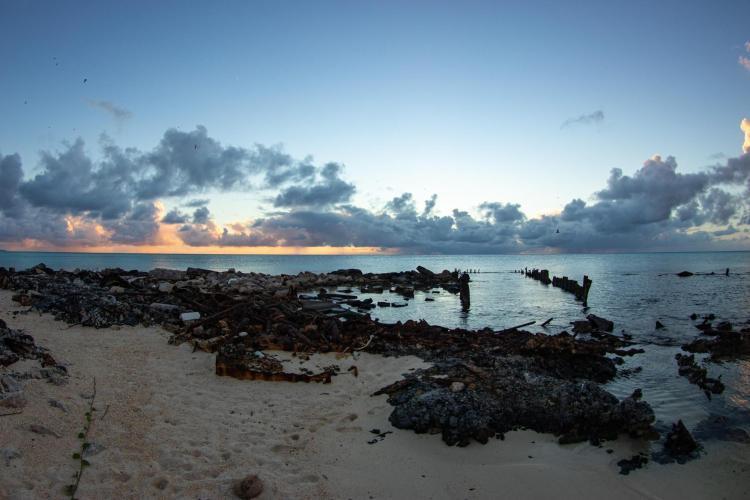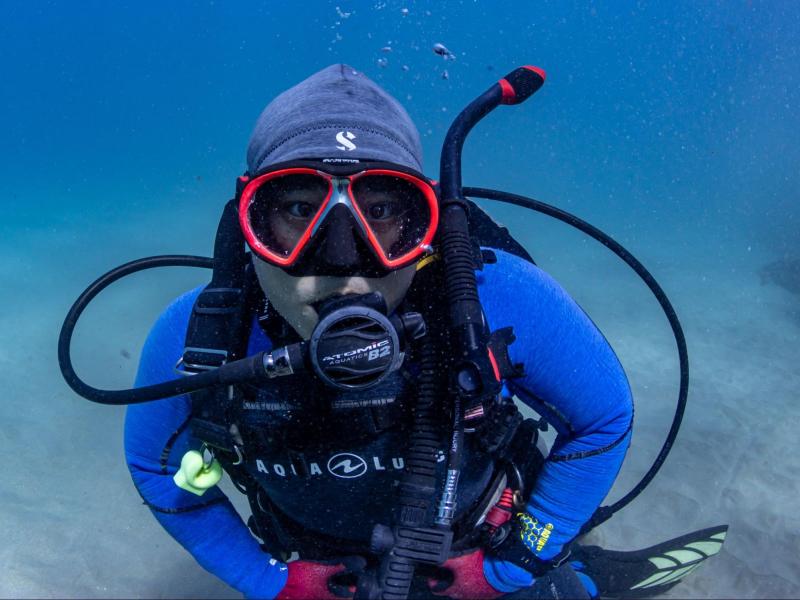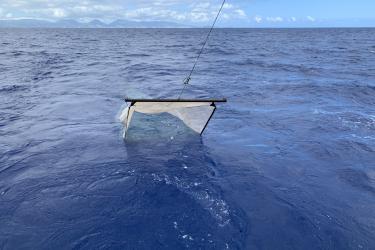Midway Atoll, also referred to by its Hawaiian name, Pihemanu Kuaihelani, consists of three islands: Sand, Eastern, and Spit. Midway was extensively altered by those who occupied it. Parts of Sand and Eastern Islands have been blasted, dredged, land filled, and paved over for commercial and military use. Despite these alterations, Midway is still a critical habitat for 17 observed seabird species, the endangered Hawaiian monk seal, and green sea turtles.
The marine debris team conducted operations from September 10th through the 12th. Because the team completed clean-up operations along Midway Atoll’s shorelines in April 2021, the primary focus of this trip was in-water derelict fishing net removal. On the 10th we conducted a combination of tow-board and swim/snorkel surveys on the northeastern side of the reef and removed a total of 8,140 pounds of derelict fishing net.
During our surveys, multiple boat teams discovered mats of algae that covered large swaths of the reef. One might think that was normal, but upon closer inspection, the team realized that this particular algae closely resembled a highly invasive species called Chondria tumulosa. To the untrained eye, C. tumulosa appears similar to other invasive algaes found in the main Hawaiian Islands, for example, Acanthophora spicifera. C. tumulosa was previously discovered at Pearl and Hermes Atoll, so the team was trained to identify the algae. When the algae was encountered, the team suspended in-water marine debris removal operations. They were afraid of spreading this algae to other parts of the atoll and other islands within the Papahānaumokuākea Marine National Monument. They sent pictures of the algae to the leading experts for species identification. The question we were all wondering was how did C. tumulosa get to Midway?
We have biosecurity protocols in place for our work at Pearl and Hermes Atoll created by NOAA, the State of Hawaii, United States Fish and Wildlife Services, and the Office of Hawaiian Affairs. With the specter of possible C. tumulosa at Midway, we immediately initiated these protocols. This entailed spraying the boats and decks with 6 percent bleach solution and soaking all personal gear, hard hats, and life jackets for at least 10 minutes. The team also decided that all land debris needed to be kept dry and placed into double-lined supersacks (double containment to eliminate potential algal spores dripping off of the debris into uncontaminated areas). With these protocols in place, we continued our shoreline marine debris removal operations.
One word to describe land debris at Midway was “deceptive”! Midway liked to play tricks. All along the beach were plenty of small scraps of net and line but hidden among those small scraps were “icebergs”.
These looked deceptively easy to pick up but resisted any forceful attempt at removal. Only after hours of digging, tugging, and towing could we break these icebergs free. At the end of two days at Midway Atoll, the team extracted a total of 7,630 pounds of land debris. We heard from the NOAA algae experts that our mystery algae was most likely C. tumulosa which was later confirmed when physical samples were processed upon our return.
On our last day at Midway Atoll, we continued to remove land debris. It was easily one of our most difficult days. Nets had to be dragged long distances to the boats and many of the nets we pulled were large “icebergs”. But the marine debris team persevered and removed a total of 8,740 pounds of derelict fishing nets and other entanglement hazards from the shorelines, beating the ‘weight-removed’ in prior days.
Working with the Papahānaumokuākea Marine National Monument’s managing agencies, we developed a plan to contain, transport, and dispose of the potentially contaminated shoreline debris. NOAA Marine Debris Project’s Chief Scientist, James Morioka, decided that the best management practice was to store the in-water debris from our first day at Midway in the secure, water-tight, 20-foot bleach container on the deck. To avoid any other potential spread, NOAA devised a plan with the United States Fish and Wildlife Service to safely store and dry all land debris collected at Midway Atoll until it could be transported and disposed of in Honolulu. We expanded our biosecurity (bleach sterilization) protocols to ensure the harmful algae was not transported from Midway Atoll to Pearl and Hermes Atoll. With these new protocols in place, we set sail for our final destination, the beautiful Pearl and Hermes Atoll.







